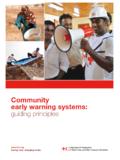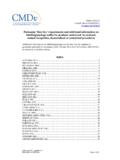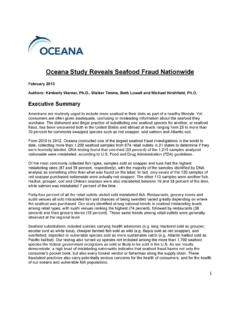Transcription of Chapter 2 :The Travel and Tourism Sector: …
1 E- Tourism at a Sri-Lanka This is not an UNCTAD official document. The views and arguments expressed here are those of the authors and are not to be taken as the views of the United Nations Acknowledgements 3 Chapter 1: Background 5 Introduction 5 Main attractions 5 Climate 5 Beaches 5 World Heritage Sites 5 Colombo 7 Festivals 7 Modern Tourism : 40 Years of Ups and Many Downs 7 Annual Tourist Arrivals 10 Main Tourism Markets and Motivations 11 Tourism within the Sri Lankan Economy 12 Use of Information and Communication Technology (ICT)
2 To Promote Tourism 13 Availability and Use of ICT in General 13 Use of ICT, Internet and Telecom by the Tourism sector 14 Use of ICT and Internet by Tourists Visiting Sri Lanka 15 Chapter 2 :The Travel and Tourism sector : Organisation and Cooperation 16 The Public sector 16 The Private sector 17 Travel & Transport 18 The Tourism Cluster 18 The New Tourism Act 19 Other stakeholders and Partnerships 20 Chapter 3.
3 Development of a National Tourism and E- Tourism Strategy 22 Introduction 22 Strategy Development by the Tourism Cluster 24 A Few Aspects of the National Carrier s Strategy 26 Other Initiatives and Partnerships 26 ASMET 27 The Centre for Eco-Cultural Studies Sri Lanka (CES) 27 Ambitions and Developments as to the Use of ICT and Internet 28 Chapter 4: Opportunities and Constraints, Assets and Best Practices 30 Opportunities for Tourism 30 Opportunities for E- Tourism 30 Constraints 31 Page 2 sur 37 Assets and Best Practices 33 References 34 Websites 34 Civil Aviation Authority Sri Lanka: 36 Publications 37 Page 3 sur 37 Acknowledgements We wish to thank the following people for generously sharing their knowledge and visions.
4 Mr Roshanjith Siriniwasa, Adviser ICT and SAARC & Trade Promotion Project of the Deutsche Gesellschafft f r Technische Zusammenarbeit GmbH (German Technical Cooperation, GTZ). Mr Niranjan Abayasena, SAARC Trade Promotion Coordinator and Coordnator Training & Seminars, GTZ. Mr Prema Cooray, Secretary General/CEO of The Ceylon Chamber of Commerce and Chairman of The Rainforest Ecolodge (Pte) Ltd. Mr Malin Hapugoda, Managing Director of Aitken Spence Hotel Managements (Pvt) Ltd. And Immediate Past President of the Tourist Hotels Association of Sri Lanka. Mr Anil Udawatte, Director - Sales & Marketing of Aitken Spence Hotel Managements (Pvt) Ltd. Mr Vasantha Leelananda, Executive Vice President and sector Head Leisure (Inbound) of John Keells Holdings Limited. Mr Gehan M.
5 Perera, Managing Director of Aitkin Spence Travels Ltd. Ms Wilja Witcombe, freelance consultant and International Coordinator of the Association of Small and Medium Enterprises in Tourism Sri Lanka (ASMET). Mr Hiran Cooray, Managing Director Jetwing Hotels Ltd. Ms Amal Goonetilleke, General Manager Sales, Sri Lanka & Maldives of the TAJ Hotels Resorts and Palaces, TAJ Group, Tata Group. Mr Anura Lokuhetty, Chief Executive Officer of the Ceylon Hotels Corporation. Mr Siri de Silva, Senior Vice President of ASMET and President of Adventurers Lanka (Pvt) Ltd and Adventurers Lanka Safaris (Pvt) Ltd. Mr Mervyn Fernandopulle, President of ASMET and Chairman and Managing Director of Airwing Tours (Pvt) Ltd. Mr Kamal S. Hapuwatta, Principal of the Sri Lanka Institute of Tourism and Hotel Management (SLITHM).
6 Dr. Prathap Ramanujam, Secretary Ministry of Tourism . Mr S. Arinda I. Elapata, Project Specialist of the Japan Bank for International Cooperation (JBIC). Mr Udaya Nanayakkana, Chairman of the Sri Lanka Tourist Board (SLTB). Mr S. Kalaiselvam, Director General, Sri Lanka Tourist Board (SLTB). Mr Sujeewa Jayasinghe, Project Director of the Centre for Eco-cultural Studies (CES), Sigiriya Eco- Tourism Project (Sigiriya Responsible Tourism Initiative). Mr Susantha, Managing Director of the New Sigiri Restaurant. Mr Laxman Ranasinghe, Elephant Safari Adventurers Lanka (Pvt) Ltd. Mr Piyasena Gamage, Proprietor of PIYA Special Green Track Elephant & Jeep Safari. Mr Rohan Ratnayake, Luckgrove Spices, Herbs and Indiginous Ayurvedic Medicine. Mr Abbas Esufally, Group Director of Hemas Holdings Ltd.
7 Mr Harith Perera, Managing Director of Hemtours (Pte) Ltd. Page 4 sur 37 Mr Niranjan Meegammana, Chief Technology/Web strategist of E Fusion. Mrs Anke Riemsma, Public Relations, Dickwella Resort. Mr Chandana De Silva, Head of Corporate Communication of Sri Lankan Airlines. Mr Suresh Bartlett, Programme/Operations Director of Information and Communication Technology Association of Sri Lanka (ICTA). Mr Dileep Mudadeniya, Additional Director General of the Sri Lanka Tourist Board (SLTB). Mr Rohana Wijeweera, Chief Information Technology Officer of Sri Lanka Telecom. Mr David Griffiths, Chief Executive Officer Sri Lanka and Maldives of The Honkong and Shanghai Banking Corporation (HSBC). Mr Pradeep Liyanamana, Director of the The Competitiveness Program (TCP), USAID Sri Lanka.
8 Mr Preminda Fernando, Program Specialist of The Competitiveness Program (TCP), USAID Sri Lanka. Dr Suranga Silva, Senior Lecturor, Department of Economics of the University of Colombo. Page 5 sur 37 Chapter 1: Background Introduction The Democratic Socialist Republic of Sri Lanka was called Ceylon until 1972. In ancient sources it is referred to as Lanka, Taprobane and also as Serendib. As a Tourism destination it indeed has everything to ensure serendipity : for making happy and unexpected discoveries. Despite its size of only 65,525 square kilometers the island offers a wide variety of landscapes and great natural beauty: from picturesque beaches to impressive mountains, from rainforests to red desert-like plains, from spectacular botanical gardens to unique wildlife.
9 The profusion of heritage and cultural attractions, including seven UNESCO World Heritage sites, means the tagline Small Island, Big Trip used in promotional campaigns hardly promises too attractions Climate Sri Lanka has a good climate for holidaymakers throughout the year. The south west monsoon brings rain to the western, southern and central regions from May to July. The north eastern monsoon occurs in the north and east in December and January. The driest and best seasons are from December to March for the west coast, the south coast and the Hill Country; from April to September for the ancient cities region and the east coast. The Low Lands have a tropical climate with an average temperature of 27C. The Central Hills are cooler, with temperatures dropping to 14C. Sri Lanka s climate means that one can always find the right beach season somewhere on the coast.
10 However, December through March are the months when most foreign tourists visit, escaping the European winter. The Christmas-New Year period is an especially popular period. Beaches Sri Lanka offers tourists great beaches and opportunities for swimming, surfing, snorkelling, scuba diving or just relaxing. Among the most famous are Aluthgama, Bentota, Induruwa, Arugam Bay, Hikkaduwa, Kalkudah Bay, Midigama, Mirissa, Tangalla, Unawatuna, Uppuveli and Nilaveli. World Heritage Sites Sri Lanka has seven UNESCO World Heritage Sites, places of outstanding value and important tourist attractions. 1 , website of the Tourism Cluster (retrieved 7 October 2006). Page 6 sur 37 The six cultural World Heritage Sites of Sri Lanka are: The Ancient City of Polonnaruwa (added in 1982).






